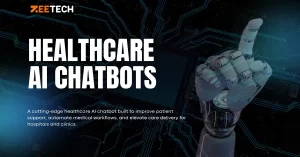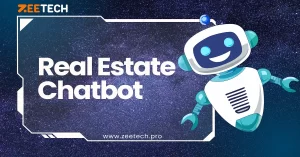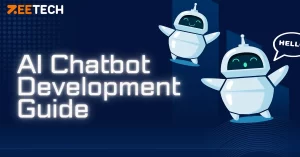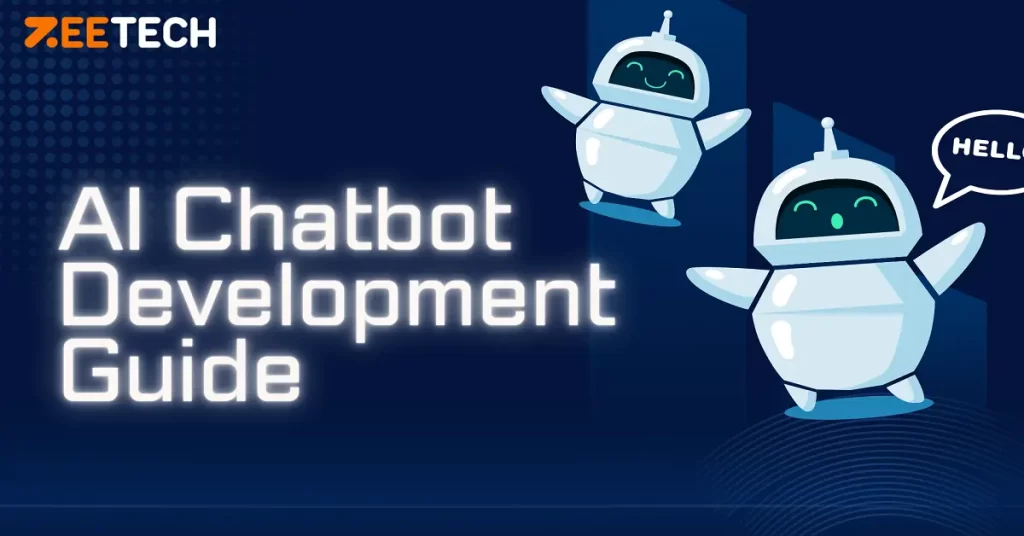In this blog, we will learn about AI chatbots before learning about their development. What are the functions of artificial intelligence chatbots? We will also examine the advantages of AI chatbot development services. How is artificial intelligence used to create contemporary chatbots? Other than this, we will discover the applications of custom AI chatbots in this blog.
What is an AI Chatbot?
It is computer software that can have voice or text conversations with people. An AI-based chatbot is one that operates by utilising artificial intelligence technology. It is similar to a virtual assistant. It has the ability to comprehend user inquiries. It can respond in a manner that makes it seem like a human is talking or chatting with users.
Chatbots can be added to any website, chatting applications, or mobile apps of businesses. They aid in answering queries, providing support, and giving information. For instance, a chatbot assists clients with purchase tracking and ticket booking. The chatbots employ artificial intelligence technologies to learn from chats. The chatbot has the capacity to improve its replies as time passes.
What is the Working of an AI Chatbot?
An AI chatbot is computer software that automates talks using artificial intelligence. It makes use of machine learning and natural language processing methods. These technologies enable human-like communication with users, clients, and customers. Conventional chatbots only employed preset rules or pre-written scripts. Conversely, chatbots with AI capabilities may understand context. They can determine the intent of the user and react appropriately. They keep learning and developing their intellect through interactions.
The enterprise AI chatbot solutions can automate customer service. They also improve user engagement and streamline processes. They can be employed by companies of any size. All of this is accomplished while cutting expenses without requiring big teams. Enterprise AI chatbot services may help clients in different ways. Additionally, they use a SaaS platform to qualify leads.
Medical institutions can use AI chatbots in healthcare to make appointments. Real estate AI chatbot can help clients get a property of their choice. These custom chatbot solutions are scalable and effective.
How are AI-Based Chatbots Separate From Traditional Chatbots?
AI chatbots are wise computer programs made to talk with people in a friendly way. They use machine learning and natural language understanding. These technologies help the bot in understanding what people say. On the other hand, the conventional chatbots only follow fixed scripts. They cannot respond to queries that are not fed into their memory. Also, they do not have the ability to customise replies.
Conversational AI chatbots can understand your words to learn what you are saying. They do this for each chat to get better with time. This means they don’t just give one-line answers. They can remember context, recognise what you really want, and adjust their replies. All this is based on your needs.
Benefits of AI Chatbots for Businesses:
- Chatbots can work the whole day without stopping. This means they keep working 24 hours a day. They offer quick support to customers at any time. They can even respond outside business hours.
- They are useful in saving costs for hiring a large customer support team. They help decrease the need for a human operator to reply to users manually. This lowers hiring and training costs.
- They ensure speedier response time. The chatbots can handle more than one chat at the same time. This lets the bot provide users with quick replies without letting them wait for a reply.
- The AI chatbot development has improved customer experience. With quick help and personalised responses, customers enjoy a smooth and satisfying experience. This builds customer trust.
- The AI-based chatbots ensure scalability as the business grows. These chatting systems and tools are capable of managing more customer queries. For this, they do not need extra staff.
- Data collection and user insights have become simpler with these tools. They can gather valuable customer data and feedback. This helps businesses understand what users want to improve services.
- The automation of small tasks can save a lot of time for employees. Chatbots can manage common tasks that humans do. This frees up human employees, and they can do other important work.
- The chatbots can offer quick and friendly support to clients. This ensures that the conversations with them are interactive. This assists the businesses in keeping their customers busy.
How AI Chatbots Let Businesses Enhance Customer Experience?
AI chatbots can be used by any business. From small startups to large corporations, every business can add them to its system. They facilitate clients in getting speedy replies to their questions. The businesses can simplify their daily jobs with these tools as well. For instance, without requiring a human employee, they may assist consumers in finding the appropriate items. An AI chatbot for appointment scheduling can plan a meeting or promptly resolve issues. They save businesses time and money since they can manage thousands of people at a time. They can perform their tasks all day without getting tired.
A conversational AI chatbot is a helpful tool for enhancing the client experience. They facilitate people’s access to prompt assistance. This lessens the hassle brought on by the wait times. They also enable companies to spend less time on tedious duties. They can give time to the tasks that have more value. An AI chatbot can be used for different tasks. They make digital communication more interesting and keep users busy. Also, they help businesses grow smoothly and efficiently.
Custom AI Chatbot Development:
Custom AI chatbot development means creating a bot for chatting that performs tasks according to specific needs. They fit the unique needs of a particular business or organisation. They do not use ready-made chatbots. This is because an already-built chatbot can contain fewer features. A custom AI chatbot is built or customised using advanced tools. This is done to work according to specific goals. They can be user support, sales, or internal operations.
Developers utilise technologies like AI, ML, and NLP in this process. They assist the chatbot with a variety of duties. Additionally, the chatbot may be linked to the business’s current databases or CRMs. This offers individualised, real-time help.
Businesses can automate routine processes with these AI chat tools. They take on their brand’s tone and voice in the process. A custom chatbot solution is a flexible and adaptable tool. It helps companies give customers a better experience.
Are There Any Types of AI Chatbots?
People assume that an AI chatbot is a small chat window on a website for user support. Chatbots can perform more tasks than that. They can be used in many different ways across mixed industries. There are many types of AI chatbots that work differently. Each type is different from the other. This is because all of these are for different uses.

Conversational AI Assistants
This particular chatbot is a refined helper. This voice-enabled chatbot is perfect for us without your hands. It can assist with a wide range of jobs, comprehend questions, and retain context. They can do this with both voice and text.
Menu-Based (Button) Chatbots
The menu-based chatbots make it easier for people to interact. They contain buttons for easy and simple communication. People do not need to type lengthy messages to communicate their issues, they can do this through buttons and menus.
Specific Domain Chatbots
These are constructed for a certain industry or use. For instance, chatbots for banks, healthcare facilities, or online retailers. A medical chatbot helps patients by checking symptoms for a disease. A banking chatbot can assist with transactions.
Task-Based Chatbots
These chatbots are created to perform tasks. They can help customers by booking their tickets or planning their times for meetings. Also, they can find the right product quickly. For example, a WhatsApp chatbot can check order status.
Retrieval Chatbots
They work by taking replies from a pre-written script stored in their knowledge base. If you ask something, it will find the most relevant answer and share it. They are good for FAQs or customer service. They know where to find the right information.
Generative Chatbots
Machine learning and natural language processing are used by generative chatbots. They come up with fresh, insightful solutions in this way. They can comprehend the message, consider it, and react appropriately. They work well for debates that are left open-ended.
Multimodal Interface Chatbots
These chatbots work through all features like voice, text, touch, and visuals. This helps them make the chats more natural. For example, a chatbot in a virtual reality environment. This can help you explore an online store. Also, it can guide you through an app.
In simple words, an AI chatbot can do more than simple chatting. It can help in different industries and businesses in countless ways. This depends on your business needs. An AI chatbot can be useful for you if you have a startup or even a large company.
What Features Do Modern AI Chatbot Development Services Provide?
To make your chatbot function better, make sure that there are the following features. These features make it intelligent, reliable, and engaging. These important elements turn a simple chat tool into a strong system. This helps the business improve its customer service. Also, it will be able to drive user engagement and support business growth. Here are some useful features of a chatbot. Get a chatbot for business growth, making sure it has all these features.
Ability to Handle Typos
A good chatbot should easily learn what users mean. It should understand the chat even if they make spelling or grammar mistakes. It should find the intended message and respond accordingly instead of getting confused.
Accurate Information
Users should be able to get current, correct information from the communication bot. Any company that wishes to win over its users’ confidence must maintain accuracy. This guarantees that consumers trust your brand.
Learning from Chats
AI chatbots get better the more they are used. They should learn from every chat. This helps them refine their responses and identify user patterns. By doing this, they can offer more natural answers to give better support to users.
Summarising Long Questions
A chatbot should be able to summarise long texts or detailed messages. It should be able to pick out the important points and reply quickly. This keeps the chat short and clear. This lets the staff focus on other problems.
Customization Options
Your chatbot responses should match the services of the brand. This is because every business has its own tone and style. A customizable chatbot can be adjusted to your specific industry needs. It evolves as your business grows.
Multi-Channel Support
Your chatbot should work across different platforms. Also, it should remember users’ past interactions on all channels. In this way, if the user switches the channel, the chatbot does not ask the user to repeat the issue.
Easy Human Handoff
Even the finest chatbot isn’t always able to tackle a difficult circumstance or issue. The chatbot should send the discussion to a human support team member quickly in this situation. This maintains the user’s experience.
Understanding Emotions
An advanced chatbot can recognise a customer’s tone or mood. It should understand the sentiment and respond appropriately. It can also alert human staff if it detects anger or distress. This ensures the issue is addressed with care.
Multi-Language Communication
If your clients come from different places, your chatbot should be able to chat in mixed languages. It must be able to identify and reply in the user’s preferred language. This makes it easier for your company to reach a worldwide audience.
Marketing Features
Not only should the customer support, but your chatbot should also help with marketing. It should share personalised product suggestions and send updates about offers. Also, it should engage users directly on channels like WhatsApp or Instagram.
Performance Analytics
The analytics tools let you see how your chatbot is performing. You can track how many users interact with it. You can check how often it misunderstands queries and how well it keeps users engaged. This helps you improve its responses.
Chatbot API Integration
A chatbot should easily connect with your existing tools. For example, a company’s CRM software, booking systems, or databases. The chatbot API integration helps provide information in real time and manage requests automatically.
Strong Data Security
Your chatbot should be reliable and use end-to-end encryption. The secure login systems also keep data safe. Companies should get chatbots that can find and protect any sensitive data that is processed by the chatbot.
Your AI chatbot becomes much more than just a basic chat tool when these functionalities are integrated. It turns into a wise helper that helps your company. Also, it will improve customer satisfaction and keep your processes running smoothly. Get a chatbot for business growth now!
What Industries Can AI Chatbot Implementation Services Work For?
| E-Commerce | AI chatbots for e-commerce find products, track orders, and give quick support. This creates quick and personalised shopping experiences. |
| Finance | They assist users in checking account details and managing expenses. Also, they can get financial advice with security and ease. |
| Healthcare | A chatbot for healthcare industry books appointments, sends reminders, and checks symptoms. It offers basic health guidance to patients. |
| Real Estate | A chatbot for real estate business assists buyers in exploring properties. Buyers can get quick answers about pricing or location details. |
| Customer Services | AI chatbots handle repetitive questions through 24/7 assistance. This decreases wait times to improve overall customer satisfaction. |
| Banking | The chatbots allow customers to check balances and report any lost cards. Also, they can make quick transactions without waiting in line. |
| Travel and Tourism | Chatbots can suggest places, book tickets or hotels, and share travel updates. They assist travellers in their overall journey. |
| HR Dept | Chatbots can onboard new staff and answer employee questions. They can plan interviews and simplify communication inside the office. |
Detailed Steps for AI Chatbot Development
We have discussed the working of AI chatbots in different industries. For example, enterprise AI chatbot solutions, an AI chatbot for healthcare, and real estate AI chatbots. Also, we have understood the types that are available for different tasks. Now, we will take a look at the process of developing an AI chatbot for any business. It is not a simple support tool as we have already discussed. It is a strong and efficient product that is designed with clear goals and business objectives. Let’s learn to build a chatbot for business growth.
Zeetech uses this approach when we work with startups, large companies, and digital teams that want more than basic automation. Our expert team makes sure that the bots we develop engage customers. We make sure they process things in a smart way for business growth.
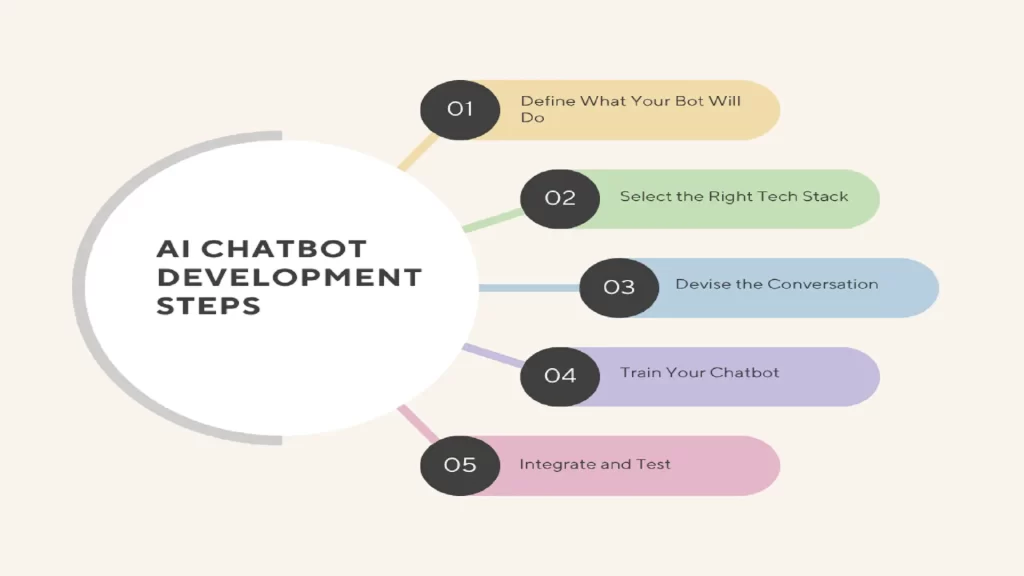
Define What Your Bot Will Do
Plan the working and daily tasks of the bot according to your industry. Define the tasks as if it is a chatbot for real estate or an enterprise AI chatbot. Set goals to check if it is working fine. These goals can be accuracy, user satisfaction, or task completion rate.
Select the Right Tech Stack
Pick reliable tools and frameworks for a chatbot. Use NLP libraries and models for understanding language. Rasa, Botpress, or Microsoft Bot Framework make development easier. Ensure your tech stack is secure, adaptable, and can store chat data.
Devise the Conversation
Prepare the chatbot to greet and interact with users. Create a flow of chat or a dialogue map to cover different types of user inputs. Use simple and friendly vocabulary. Also, you will need to prepare fallback replies for unexpected questions.
Train Your Chatbot
Use mixed datasets to train your chatbot. It will be able to comprehend different slang terms, accents, and expressions. Continue refining it based on user input and ongoing education. Update its data as well as compare performances using A/B testing to improve.
Integrate and Test
Add your chatbot to your website or app. Be careful to properly test it across a variety of devices. Before launching, test in various scenarios to address any issues. Inspect its security and performance. Examine its integration with other systems, such as your database or CRM.
Launch and Improve
After deploying it, gather user feedback and utilise analytics to watch performance. Keep an eye on satisfaction levels, accuracy, and reaction time. Continue adding new features and data to your chatbot. To keep it operating efficiently, maintain it with a committed staff.
AI Chatbot Development and Future Trends
Faster and more human-like interactions are the main goals of AI chatbot development in the future. Enterprise AI chatbot development companies may develop chatbots with the aid of a solid deployment plan. They engage users naturally and improve efficiency. Modern chatbot implementation services now include advanced features. They can have voice chat, recognise emotions, and chat in various languages. This helps them reach more people.
Voice-enabled chatbots are becoming important for every industry. This includes an AI chatbot in healthcare, banking, and travel. They offer hands-free help for users on the go. Similarly, AI chatbots for appointment scheduling simplify daily tasks. They can book meetings, send updates, and review calendars automatically.
Global expansion is also driving the need for multilingual chatbot platforms. It allows companies to communicate with customers in their native languages. This is done through real-time translation. This not only improves accessibility but also builds stronger customer connections.
Chatbots will continue to develop in the years to come. They will accomplish this through more intelligent integrations, improved personalisation, and emotional intelligence. Companies will continue to lead if they invest in these developments. This will provide human-like experiences that increase long-term growth and engagement.



